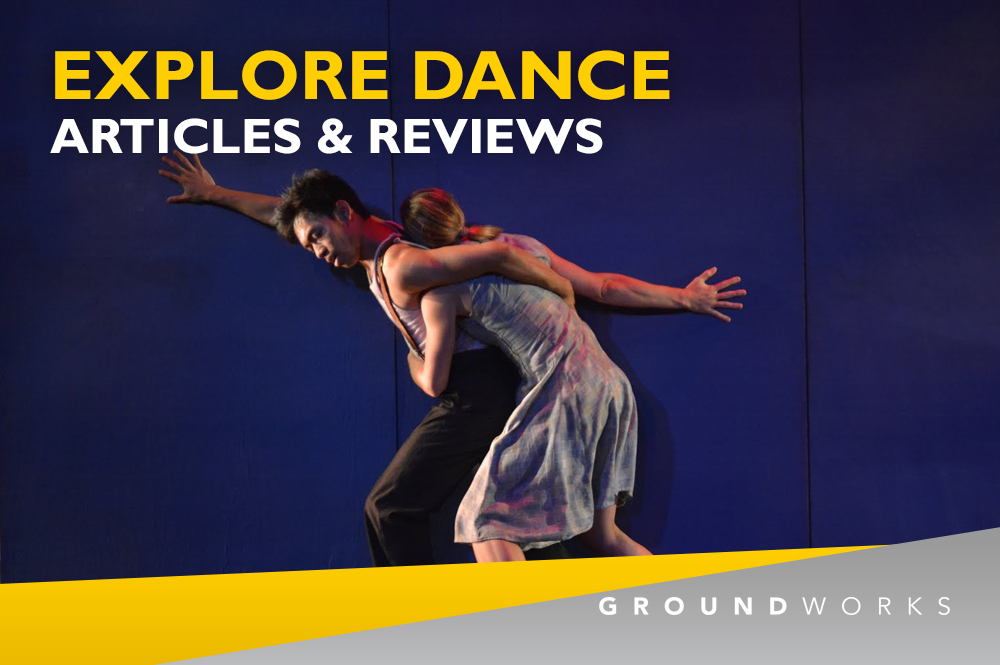Project Description
Disillusion, Low Burning Human Drama and The Blues Inspire GroundWorks DanceTheater’s Latest Triumph
By Steve Sucato, Explore Dance
For its 13th annual summer season production at Cleveland Heights’ Cain Park, GroundWorks DanceTheater presented three works including a world premiere and introduced audiences to its two newest company dancers, Pittsburgh-native and former Parsons Dance member Lauren Garson, and recent Juilliard graduate Michael Marquez.
The humid matinee program on July 19 in the sweat box known as Cain Park’s Alma Theater opened up with a reprise of Miami-based choreographer Rosie Hererra’s “House Broken” (2014). The dark comedy about suburban life and its disillusions struck a purposeful balance between humor and heartache. The contemporary work, which I reviewed in February of 2014 (click here to read) held the same charms as in its premiere drawing the audience in with its collection of everyday life vignettes taken to quirky, absurd and often poignant extremes.
Set to familiar tunes by Tom Jones, The Turtles and Pete Seeger, “House Broken” began with sound effects of failed attempts to start a pull-start lawnmower. Then the roar of the engine coming to life launched the work’s five dancers into a series of emotional ups and downs portraying a host of archetypal characters. A bored Marquez pitched golf balls (actually ping pong balls) into the audience, urban “super dad” Damien Highfield aboard a working treadmill encapsulated in minutes his daily march through life in humorous fashion pushing a baby carriage in three piece suit while talking on a cell phone and then stripping off his business attire and showering and shaving. The work’s three female dancers Garson, Annika Sheaff and 2015 Cleveland Arts Prize recipient, Felise Bagley were seen and heard barking like dogs, corralling golf balls with their crotches and whipping their heads and long hair in violent circles. Adeptly performed, the neatly packaged and memorable dance work was a sobering reminder of “life’s not so rich pageant.”
The program’s second work, “Remora,” whose definition can mean a type of fish having on its head a sucking disk by which it can attach itself to other aquatic life, ships, and other moving objects, began its creation in the studio at Cleveland State University literally from the roll of dice. That was one of the devices choreographer Eric Michael Handman, an associate professor at the University of Utah’s Department of Modern Dance, used to direct GroundWorks’ dancers into movement creation. The dice role, using one standard die and two with action words on them, initiated movement exercises GroundWorks’ five dancers and Handman used to help create material for the work. Unlike the traditional choreographic model where the choreographer makes up steps and teaches them to the dancers to perform, Handman is one of a growing number of choreographers who lean heavily on the dancers to create movement. He directed the creative process and then assembled, organized and edited the dancer generated material into a finished work. The results were impressive.
The world premiere of the abstract “Remora” set to a moody, cinematic original score by fellow University of Utah faculty member Michael Wall, meandered through a series of undefined personal relationships between the dancers that Handleman described in an earlier interview I had with him “as a low burning human drama.”
Delivered in a succession of solos, duets, trios and group sections, the work utilized a familiar contemporary movement language seen in many of GroundWorks’ pieces but with a fresh perspective. Like the aforementioned fish, the dancers latched onto each other at times and were carried along in movement phrases that were technically vibrant and visually appealing. Of note were a sharp, angular solo by Bagley that breathed elegance and a solo by Sheaff in which she moved briskly in a semi-crouched position a la a martial arts kata. It was the work’s final duet danced by Bagley and Highfield however that really stood apart (and quite frankly could have stood on its own).
Danced to music emotive of longing, the pair pushed, pulled and collected each other in wanting embraces. A touch of an arm or a nudge of a leg sent the two swirling in and out of deep body leans and meaningful grasps that altogether spoke directly to the heart.
The program’s final work “Boom Boom” (2009), by GroundWorks’ artistic director David Shimotakahara set a different tone; one of a bluesy romp befitting a summertime dance program.
Danced to foot-stomping tunes like Mae “Big Mama” Thornton’s “Hound Dog” and John Lee Hooker’s “Boom Boom” along with songs of heartache like Aretha Franklin’s “Today I Sing the Blues” and Odetta’s “Another Man Done Gone,” the solidly-crafted work mixed playful strutting, shimmying and shaking with melancholy sinking and swaying.
With the Cain Park program GroundWorks’s dancers as a unit once again showcased a skillset and performance quality unrivaled in the region. Both Garson and Marquez acquitted themselves nicely in their debuts. Garson, a more natural fit, impressed with her expressiveness and mature stage presence.
GroundWorks Dance Theater will repeat this program in two free performances July 31 and August 1 at Akron Ohio’s Glendale Cemetery as part of The Heinz Poll Summer Dance Festival.

